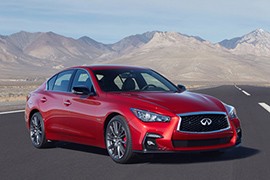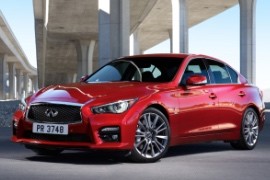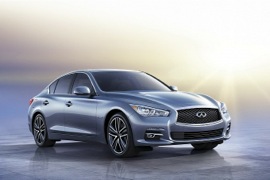INFINITI Q50 Models/Series Timeline, Specifications & Photos
First production year: 2013
Engines: Gasoline, Hybrid, Diesel, Hybrid gasoline
In a market crowded with small luxury sedans, there were many reasons why a customer would choose the Infiniti Q50. And to make it more simple, the distinctive sharp design was one of the vehicle’s strongest points.
With such a beautifully designed exterior came a soft sporty interior fitted with quality materials all around.
The center console consisted of two screens, one to display the navigation and the images from the 360 degree camera and the other one to offer easy access to the infotainment system.
Unusual for a 2018, the Q50 did not have smartphone integration (AppleCar Play or Android auto) - a feature that most vehicles in the luxury sedan class offered in 2018.
While the passengers in the front seats would seat comfortably, the rear seats were not suitable for tall adults due to limited legroom and headroom.
The new Q50 kept the direct adaptive steering system, thus there were no mechanical connections between the steering wheel and the wheels. Some might have considered that with this system the steering was not as precise.
The sportiest along the trim levels was the special Red Sport 400 edition that featured a 3.-liter turbocharged V6 engine, a ferociously quick unit. Every trim level was equipped with a standard 7-speed automatic transmission. The starting price of this model was around $52,000.
For those considering the Red Sport 400 was too expensive, the Luxe trim level was equipped with a 3.0-liter V6.
A hybrid version was also available, with a 3.5-liter V6, an electric motor and lithium ion batteries. This version offered great fuel economy and was well loaded, however, its price was around $51,000.
Updated for 2016, the compact executive saloon was luxury and technology oriented.
Some of the major updates were with next-generation direct adaptive steering system and the dynamic digital suspension available with the V6 engine. The direct adaptive steering offered a quicker response and removed vibrations.
While the Q50 was not an obvious choice, the mainstream engineering used turned the luxurious saloon into a great choice for the people interested in the Nissan’s luxury brand.
The cabin was one of the roomiest in the class, with impressive legroom and headroom for the rear passengers. Even if the luxurious sedan offered seating for 5, the 3rd seat in the rear was more suitable for children due to the high central transmission tunnel.
Comfort was one of the Q50’s strongest points, with incredibly comfortable chairs equipped with side bolsters for better support in the Sport version.
The brand’s tie-up with Mercedes Benz brought a power 2.0-liter engine that developed 208 hp and 258 lb.-ft of torque.
New for 2016, a 3.0-liter V6 engine was added to the range, an unit that cranked out 300 hp with the 3.0t trim level and 400 hp with the range-topping Q50 Red Sport 400.
The interior was fitted with nicely finished high quality materials. The center console consisted mainly of two screens, each to display different information. The upper screen displayed the navigation and the images transmitted from the rear view camera, while the 2nd screen would offer easy access to the infotainment system.
Infiniti ditched the G-series sedan and replaced it with the Q50 in 2013, introducing a new naming system in its lineup.
Based on the same FM platform shared with the Z-series and the EX/QX/FX models, the Q50 was the equivalent of the Japanese Nissan Skyline. It heralded a new era in Nissan's lineup and tried to steer emotions, convincing the customers that an Infinity can be bold, sporty, and elegant at the same time. Last but not least, it shared some of its technology with Mercedes-Benz.
From the design point of view, the sharp angles and lines emerged from the front of the car onto the profile, on the sculptured doors, and reached the rear quarter panels. Its eye-like swept-back headlights sported an LED line on the upper side. From its sides, the Q50 showed a cab-rearward design with a short deck at the back and a raked-froward rear windscreen. At the back, two horizontal chromed trims emphasized the car's width. The upper one linked the rear LED taillights on the trunk.
The interior revealed a luxurious cabin with a pair of bolstered front seats separated by a tall center console. On the upper side of the center stack, Nissan installed a touch-screen infotainment system that combined more functions than on the previous G-models. A secondary touch-screen sported the climate control functions, thus limiting the number of physical buttons on the center stack. At the back, the bench was fit for two adult passengers, separated by a tall center tunnel that limited the legroom for a third one.
Under the hood, Nissan installed a choice of gasoline, diesel, and hybrid powertrains. The 2.2-liter units were carried over from Mercedes-Benz and were not available on the U.S. market.


